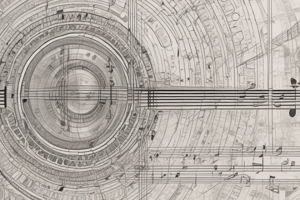Podcast
Questions and Answers
What aspect of a sound does the attack represent?
What aspect of a sound does the attack represent?
- Development of the sound
- Initial part of the sound (correct)
- Gradual fading of the sound
- Overall texture of the music
Which instrument is often associated with a 'bright' timbre?
Which instrument is often associated with a 'bright' timbre?
- Cello
- Trombone
- Double bass
- Violin (correct)
What does the term 'warm' signify when describing timbre?
What does the term 'warm' signify when describing timbre?
- Distinct and easy to distinguish
- Intense and powerful
- Mellow and low-pitched (correct)
- Metallic and high-pitched
Which instrument is often associated with a 'dark' timbre?
Which instrument is often associated with a 'dark' timbre?
What term describes a sound that is less loud and more subtle?
What term describes a sound that is less loud and more subtle?
In a rock song, which instrument may take a more substantial role according to the text?
In a rock song, which instrument may take a more substantial role according to the text?
What is timbre in music?
What is timbre in music?
Which instrument has a timbre characterized by warm, resonant tones?
Which instrument has a timbre characterized by warm, resonant tones?
How do string instruments like violin and guitar produce sound?
How do string instruments like violin and guitar produce sound?
Which type of instruments create sound through the vibration of their reed?
Which type of instruments create sound through the vibration of their reed?
How do brass instruments like trumpet and trombone produce sound?
How do brass instruments like trumpet and trombone produce sound?
Which term refers to how instruments interact and blend together in a musical composition?
Which term refers to how instruments interact and blend together in a musical composition?
Flashcards are hidden until you start studying
Study Notes
Understanding Timbre in Music
Timbre, sometimes referred to as tone color, is a fundamental aspect of music that contributes to the richness and complexity of sounds. It's the characteristic quality that makes different instruments and voices sound distinct, even when they play the same pitch and rhythm. In this article, we'll explore timbre's role in music, how it relates to the sounds of instruments, and how we identify and describe it.
Instruments and Their Timbre
Every musical instrument has its unique timbre, which is a result of its physical properties, such as resonance, the material, and the way it's played.
For example, a piano's timbre is associated with its hammers striking strings, resulting in a crisp and clear sound. In contrast, a cello's timbre is characterized by its warm, resonant tones produced by the vibrating strings and the instrument's wooden body.
String instruments like violin and guitar produce their sound by plucking or strumming the strings, while woodwinds like clarinet and flute produce their sound by the vibration of their reed. Brass instruments, such as trumpet and trombone, produce their sound through the vibration of their player's lips and the instrument's bell. Percussion instruments, like drums and cymbals, create their sound through vibration caused by striking them.
Timbre and Texture
Timbre also plays a role in creating texture, which refers to how instruments interact and blend together in a musical composition. Each instrument contributes to the overall texture based on its timbre, with some instruments being more prominent or recessive, depending on their role in the music. For instance, the piano may be more prominent in a classical piece, while guitars and drums may take a more substantial role in a rock song.
Identifying Timbre
Identifying timbre can be challenging, but it becomes more intuitive with practice. One way to identify timbre is to listen to the attack, sustain, and decay of a sound. The attack is the initial part of the sound, the sustain is its development, and the decay is the gradual fading of the sound.
Another way to identify timbre is to listen for certain characteristics of a sound, such as its brightness, warmth, and clarity. For example, a piano may sound bright and clear, while a cello may sound warm and resonant.
Timbre Words
Musicians and music theorists often use specific terms to describe timbre, such as:
- Bright: This term refers to a sound that is more metallic and high-pitched, often associated with instruments like violin and flute.
- Warm: This term refers to a sound that is more mellow and low-pitched, often associated with instruments like cello and trombone.
- Dark: This term refers to a sound that is more muted and soft, often associated with instruments like organ and double bass.
- Clear: This term refers to a sound that is more distinct and easy to distinguish, often associated with instruments like piano and clarinet.
- Soft: This term refers to a sound that is less loud and more subtle, often associated with instruments like guitar and piccolo.
- Loud: This term refers to a sound that is more intense and powerful, often associated with instruments like drums and trumpet.
Summary
Timbre is a fundamental element of music that contributes to a piece's overall texture and richness. It's a characteristic quality that makes each instrument and voice sound unique. By understanding timbre, you'll be able to better appreciate the complexities of music and recognize the intricate interplay of instruments in a composition.
Studying That Suits You
Use AI to generate personalized quizzes and flashcards to suit your learning preferences.




